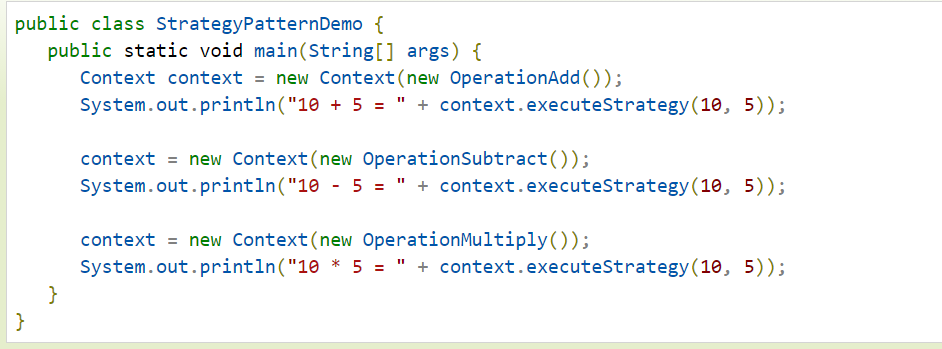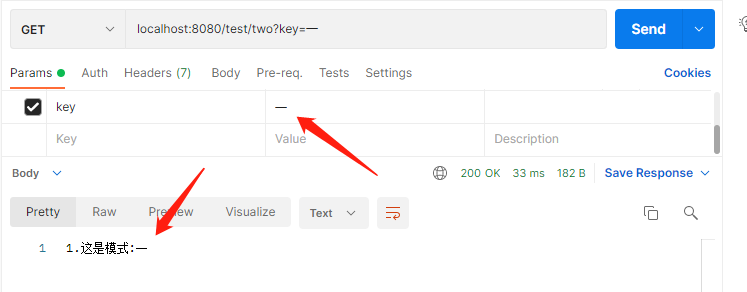策略模式:定義了演算法族,分別封裝起來,讓它們之間可以互相替換,此模式讓演算法的變化獨立於使用演算法的客戶。
傳統的策略模式一般是建立公共介面、定義公共方法——》然後建立實體類實現公共介面、根據各自的邏輯重寫公共方法——》建立一個行為隨著策略物件改變而改變的 context 物件——》根據不同的傳參,呼叫不同的介面實現類方法,達到只改變引數即可獲得不同結果的目的。


但是也可以明顯發現,這種策略模式的實現方式,程式碼量較大,而且還要自定義要傳遞的引數,可能會引入一定數量的if/else,有一定的優化空間,接下來,我會結合實際開發經驗,分享一種策略模式的優化方式,進一步優化程式碼結構、減少程式碼量。
首先,必不可少的需要建立公共介面、定義公共方法,然後建立實體類實現公共介面、根據各自的邏輯重寫公共方法,參考程式碼如下:
定義公共介面CommonService,以及公共方法push()
1 package com.itcq.service.StrategyPattern;
2
3 public interface CommonService {
4 String push(String key);
5 }
建立三個不同的介面實現類,重寫push()方法
1 package com.itcq.service.StrategyPattern;
2 import org.springframework.stereotype.Service;
3
4 @Service
5 public class TestOne implements CommonService {
6 @Override
7 public String push(String key) {
8 return "1.這是模式:" + key;
9 }
10 }
1 package com.itcq.service.StrategyPattern;
2
3 import org.springframework.stereotype.Service;
4
5 @Service
6 public class TestTwo implements CommonService{
7 @Override
8 public String push(String key) {
9 return "2.這是模式:"+key;
10 }
11 }
1 package com.itcq.service.StrategyPattern;
2 import org.springframework.stereotype.Service;
3
4 @Service
5 public class TestThree implements CommonService{
6 @Override
7 public String push(String key) {
8 return "3.這是模式:"+key;
9 }
10 }
接下來就是重點,我們利用到springboot初始化Bean的方式結合HashMap,來實現對策略模式的優化
1 @Service
2 public class TestServiceTwo implements InitializingBean {
3
4 @Autowired
5 private ApplicationContext applicationContext;
6
7 private HashMap<String, CommonService> hashmap = new HashMap<>();
8
9 @Override
10 public void afterPropertiesSet() {
11
12 hashmap.put(StrategyTestEnum.STRATEGY_ONE.getTitle(), new TestOne());
13 hashmap.put(StrategyTestEnum.STRATEGY_TWO.getTitle(), this.applicationContext.getBean(TestTwo.class));
14 hashmap.put(StrategyTestEnum.STRATEGY_THREE.getTitle(), this.applicationContext.getBean(TestThree.class));
15 }
16 }
1 @Getter
2 public enum StrategyTestEnum {
3 STRATEGY_ONE("一", "模式一"),
4 STRATEGY_TWO("二", "模式二"),
5 STRATEGY_THREE("三", "模式三"),
6 ;
7
8 private String title;
9 private String value;
10
11 StrategyTestEnum(String title, String value) {
12 this.title = title;
13 this.value = value;
14 }
15 }
TestServiceTwo實現InitializingBean介面,InitializingBean介面為bean提供了初始化方法的方式,它只包括afterPropertiesSet方法,凡是繼承該介面的類,在初始化bean的時候都會執行該方法。
定義一個hashmap集合,用來儲存不同的公共介面實現類物件,這裡把引數抽取成一個列舉類,利用SpringBoot的高階容器ApplicationContext,獲取Bean物件,當然這裡直接new一個實現類物件也是可以的,將不同的引數和實現物件封裝到map集合中,實現引數和邏輯一一對應。
測試方法如下,通過hashmap的key獲取對應的實現類物件,這樣就不必再自定義引數型別,徹底消除了if/else,也不用暴露給方法呼叫者過多的業務邏輯。
1 public String testMethod2(String key) {
2
3 CommonService commonService = hashmap.get(key);
4 Assert.notNull(commonService, "引數錯誤,找不到模式");
5 return commonService.push(key);
6 }
最後在controller層呼叫方法,進行測試:
1 @Autowired
2 private TestServiceTwo testServiceTwo;
3
4 @GetMapping("/test/two")
5 public String testMethodTwo(@RequestParam(name = "key") String key) {
6
7 return testServiceTwo.testMethod2(key);
8 }
測試結果如下:
引數正確情況下:

引數錯誤情況下:


利用這種自定義初始化bean+hashmap的方式完成了對策略模式的優化,優化了程式碼的結構,並且徹底消除了if/else,個人認為可以很好地提升程式碼質量。